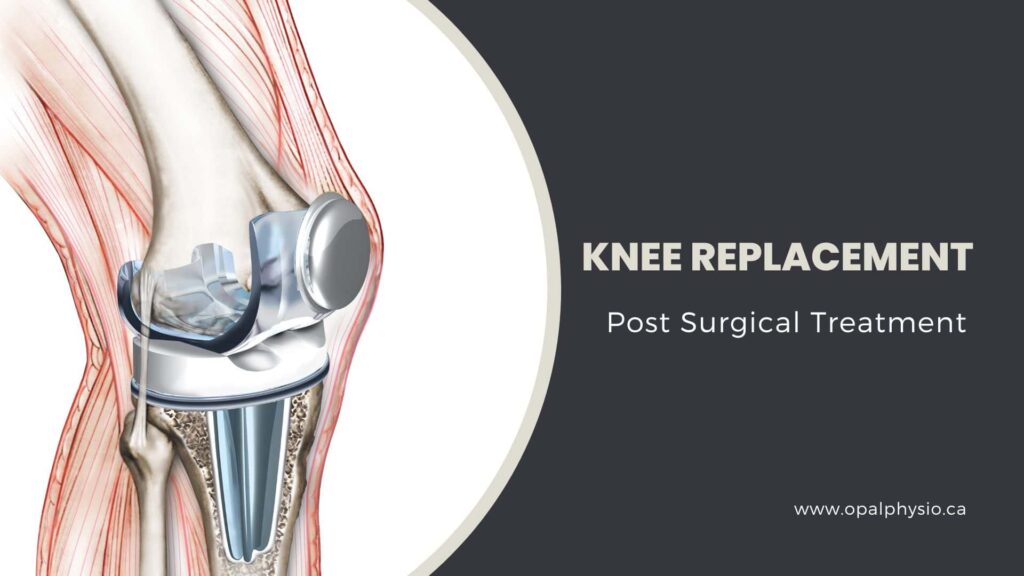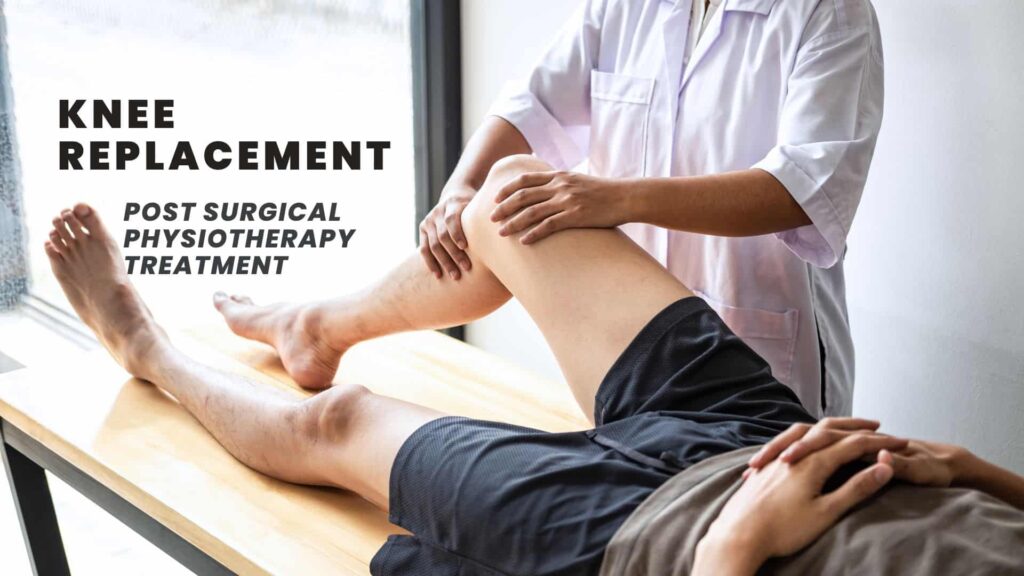Knee Replacement Physiotherapy Treatment
Knee replacement surgery, also known as knee arthroplasty, is a standard surgical procedure performed to treat severe knee joint damage, relieve pain and improve mobility. It’s typically recommended for individuals with conditions such as osteoarthritis, rheumatoid arthritis, or traumatic injuries that have resulted in significant joint damage.
After knee replacement surgery, physiotherapy and exercise are crucial parts of the rehabilitation process to help patients regain strength, mobility, and function.
Our well-trained orthopedic physiotherapists at Opal Physio Langley help reduce knee pain and improve range of motion, strength, flexibility, and mobility post-surgically. We aim to help patients recovering from knee joint replacement surgery restore movement and their functional abilities.

Knee Replacement Surgery:
Knee replacement surgery involves removing damaged portions of the knee joint and replacing them with artificial components made of metal and plastic. There are two primary types of knee replacement surgery: total knee replacement (TKR) and partial knee replacement (PKR), depending on the extent of damage to the knee joint.
Risks and Complications After Knee Replacement
While relatively safe, some risks and complications can occur after a knee joint replacement:
- Infection: Occurs in <2% of patients
- Stiffness: A common complication that can be treated with regular physiotherapy
- Implant wear: Higher risk with increased activity
- Clicking/popping: Usually not problematic
- Blood clots: Reduced with early mobility and medication
- Nerve damage: Usually resolves over time
With appropriate physiotherapy, most patients see significant improvements in knee pain, mobility, and quality of life after knee replacement surgery. Physiotherapy plays an essential role in the rehabilitation process.

Physiotherapy After Knee Replacement
The main goal of physiotherapy after knee replacement is to help patients regain strength, mobility, and function in the affected knee. The physiotherapy program is customized to the patient’s specific needs.
Typical Physiotherapy Timeline After Knee Replacement
Early Postoperative Phase: In the initial days after surgery, physiotherapy focuses on preventing complications such as blood clots and promoting safe movement. Patients are typically encouraged to start gentle exercises and practice knee mobility. They are also taught how to use assistive devices like crutches or walkers.
1-2 weeks after surgery: Outpatient physiotherapy focuses on reducing swelling, managing pain, improving range of motion and strength, and building confidence with mobility. Patients work on bending the knee to 90 degrees, fully straightening the knee, and walking for 15 minutes.
3-6 weeks after surgery: Physiotherapy progresses to building endurance through low-impact activities like cycling. The goal is to bend the knee to 120 degrees, climb stairs, and perform light household activities. Many patients transition from walkers to canes or have no assistive devices.
2-3 months after surgery, the frequency of physiotherapy often decreases as patients focus on maintaining gains with home exercise programs. The knee replacement feels more mobile, and most daily activities can be resumed.
6-12 months after surgery: Some patients continue physiotherapy 1x/week to once every 2 weeks during this time to optimize recovery before being discharged.
Physiotherapy Rehabilitation After Knee Replacement
Common physiotherapy treatments after knee replacement include:
- Strengthening and Range of Motion: As the patient progresses in their recovery, physiotherapy will include exercises to improve the range of motion and strengthen the muscles surrounding the knee joint. This helps in regaining flexibility and stability.
- Pain Management: Physiotherapists may use various modalities such as ice, heat, or electrical stimulation to manage postoperative pain and swelling.
- Gait Training: Learning to walk appropriately with the new knee joint is critical to recovery. Physiotherapists work with patients to ensure they can walk comfortably and safely.
- Functional Activities: Physiotherapy includes training for functional activities like climbing stairs, sitting and standing up. These are essential for restoring a patient’s ability to perform everyday tasks.
- Home Exercise Program: Patients are often given a home exercise program to continue their rehabilitation independently between physiotherapy sessions. Consistency in performing these exercises is crucial for a successful recovery.
- Gradual Progression: The physiotherapy program is gradually adjusted as the patient improves. The focus may shift from acute recovery to long-term joint health, function maintenance, and activity-specific training.
- Monitoring and Support: Regular follow-up with a physiotherapist and the surgical team ensures that the patient’s progress is monitored and any issues or concerns are addressed promptly.
Benefits of Physiotherapy After Knee Replacement
Physiotherapy provides many benefits after a knee replacement:
- Improves mobility and range of motion
- Builds muscle strength
- Prevents scar tissue restrictions and limitations
- Promotes healing through increased blood flow from exercises
- Restores ability to perform daily activities
- Provides education on proper movement and recovery
Recovery time after knee joint replacement surgery can vary from person to person, but physiotherapy is a key component of the rehabilitation process, and it can significantly improve a patient’s outcomes and quality of life. Patients should always follow their healthcare provider’s recommendations and adhere to their physiotherapy program to achieve the best results.
Don’t toil alone with recovery after a knee replacement surgery. Our skilled physiotherapists develop personalized rehab programs to help you regain function fast. Book an appointment or call us today to learn more about our active rehabilitation services after a Knee replacement surgery!
